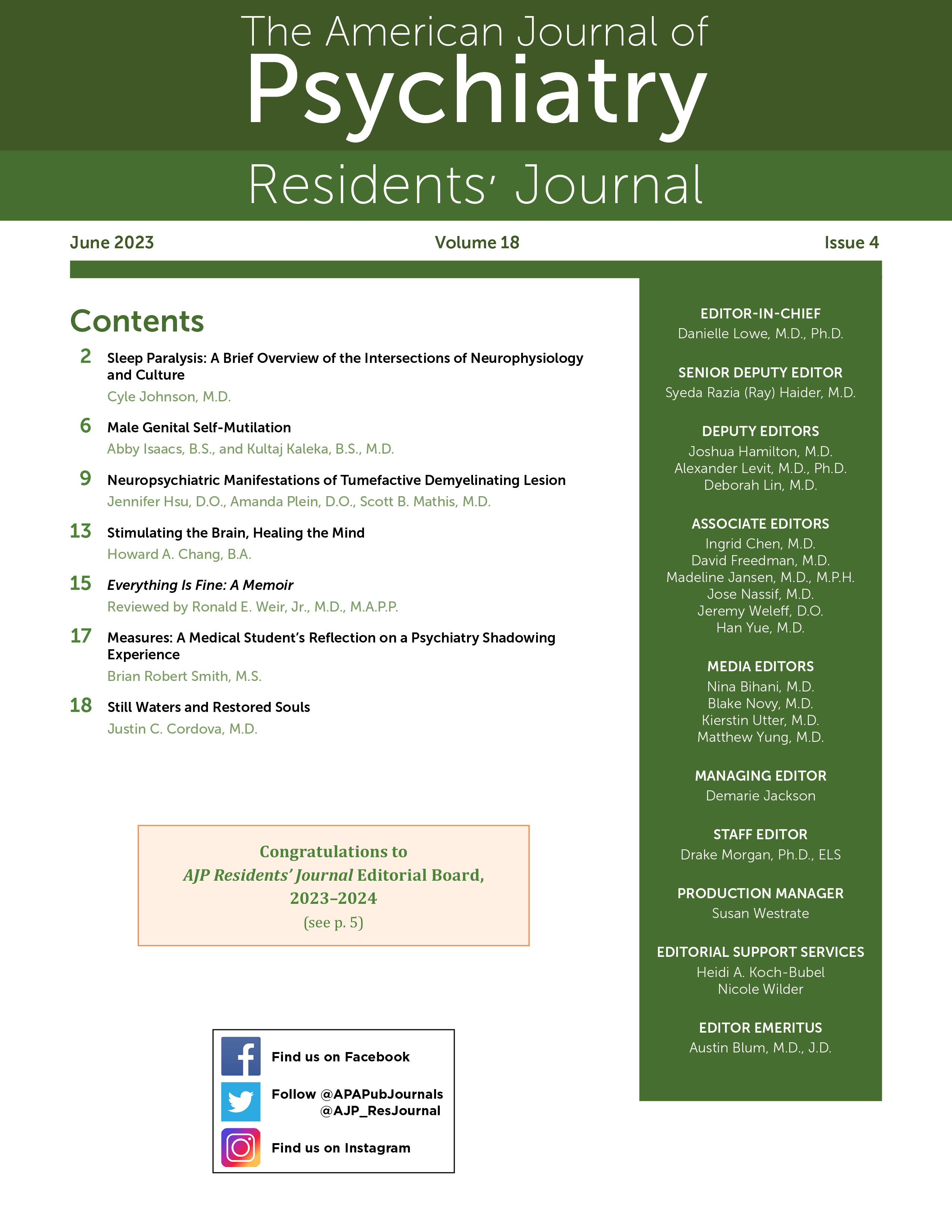It was a mesmerizing scene: a patient with treatment-resistant schizophrenia whose hallucinations and delusions were being titrated in real time by a neurologist operating an iPad. A click here, and her hallucinations would improve; a click there, and they would worsen. In that moment, she might have said that her physician was influencing her thoughts by transmitting electrical impulses through electrodes implanted in her brain. Such a statement would ordinarily be construed as a classic delusion arising from her disease. But in this setting, it would have been entirely factual.
I was witnessing the first known patient to receive deep brain stimulation (DBS) of the substantia nigra pars reticulata for the treatment of refractory schizophrenia, as described in a recent case report (
1). Within 12 weeks, her delusions had remitted, and she maintained this improvement more than 1 year later. Few other case reports have shown DBS-induced improvements in refractory schizophrenia, and in these cases, different brain regions (e.g., the nucleus accumbens) were stimulated, which required much higher voltage and caused persistent psychiatric adverse effects (
2). Determining the optimal brain targets for DBS in schizophrenia is a complex issue that is an active area of investigation.
Initially approved by the U.S. Food and Drug Administration (FDA) in 1997 to treat essential tremor and tremor associated with Parkinson’s disease, DBS is now used in the context of other neurological disorders, such as epilepsy and dystonia (
3). DBS begins with neurosurgery to place electrodes in brain structures responsible for coordinating movement. Physicians use an iPad or smartphone to control a pulse generator implanted beneath the collarbone that delivers electrical signals to these brain structures. With just a few clicks, tremors can remit in real time.
A better understanding of the underlying neurocircuitry largely explains the greater success of DBS in treating movement disorders compared with psychiatric disorders. For individuals with Parkinson’s disease, stimulation of the subthalamic nucleus or globus pallidus interna reduces stiffness and tremor, and this can be understood in terms of knowing how these brain structures modulate movement. Despite characteristic abnormalities, such as lateral ventricular enlargement, cortical thinning, and subcortical volume reductions, the neurocircuitry underlying schizophrenia is not strongly localized in the same way. Instead, emphasis is placed on neurochemical disturbances (e.g., dopamine) and accompanying pharmacological interventions (e.g., neuroleptics) (
2).
Unfortunately, 12%–20% of all patients with schizophrenia have symptoms that are classified as “ultra–treatment-resistant,” meaning that there are ongoing symptoms and functional impairment despite a trial of clozapine—the most effective neuroleptic for the treatment of schizophrenia—following two other unsuccessful trials of different neuroleptics (
4). Indeed, these patients may have the most to gain from interventional psychiatric treatments such as DBS. However, effective use of these treatments necessitates the identification of valid brain targets for stimulation and more research into the underlying patterns of neural dysconnectivity in schizophrenia. The treatment of obsessive-compulsive disorder (OCD) illustrates that DBS can be realistically applied within the psychiatric domain. On the basis of evidence that stimulating the ventral capsule–ventral striatum provides efficacious treatment for individuals with treatment-resistant OCD, the FDA granted humanitarian device exemption status to DBS for this indication in 2009 (
3). DBS has also demonstrated efficacy among patients with treatment-resistant depression via stimulation of the subcallosal cingulate gyrus, and emerging research is revealing its potential use among individuals with Tourette’s syndrome, obesity, anorexia, and addiction (
3).
Moving forward, procedure-based treatments such as DBS will likely play an increasingly important role alongside pharmacology and psychotherapy in the treatment of psychiatric disorders. I marveled at seeing psychiatrists “zap” the hallucinations out of a patient debilitated by a disease for which interventional psychiatry is beginning to make serious inroads. Intrigued by what the near future holds, I recall the words of psychologist Dr. Kay Jamison, who just 2 years before DBS gained its first-ever FDA approval wrote of “a wonderful kind of excitement in modern neuroscience, a romantic, moon-walk sense of exploring and setting out for new frontiers” (
5).
Acknowledgments
The author thanks Ankur Butala, M.D., for his invitation to observe the procedure described in this commentary.
